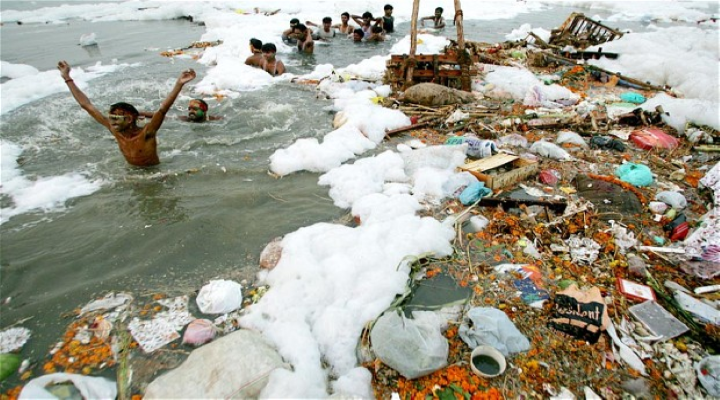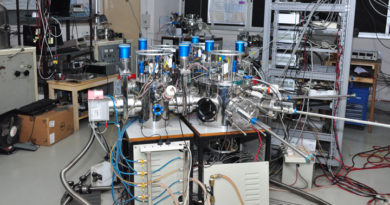Arsenic Contamination In Drinking Water Of Ganga
STUDY OF ARSENIC CONTAMINATION IN DRINKING WATER OF GANGA‘S BASIN IN DIGHA (PATNA)
Smriti1, Ashutosh Kumar2 and R.T. Singh3
1 & 2 Research Scholar. Dept. of Chemistry, V. K. S. University, Ara
3. Professor of Chemistry and the Dean of the Faculty of Science,
V. K. S. University, Ara
Key Words: Ground water, arsenic contamination, arsenicosis, public awareness.
ABSTRACT
The experiment was conducted to monitor the Arsenic contamination of ground water of Selected sites of Digha (Patna,) near Ganga’s basin. Ground water Sampling was carried out at 22 locations. The analysis report shows that arsenic Concentration in ground water exceeds the permissible level. Several Peoples of related area Suffers from arsenic health hazards. There is a need of Public awareness to arsenic contamination in related areas.
Introduction:
Ground Water is ultimate most Suitable fresh water resource with nearly balanced concentration of salts for human consumption. Over the last thirty years the use of pure waters for drinking and other purposes have been the dominant along with the concern of better environment, the development of new technology has grown up steadily but water purification in the community level almost remains the same. Arsenic contamination in ground water is a wide spread phenomenon which causes many health problems, such as lung, liver, kidney, bladder cancer, black foot disease, Arsenicosis etc.
Sampling and Sampling Sites :
The significance of a chemical analysis depends to a large extent on the sampling Programme. First of all plastic containers were taken for the collection of water samples. It was treated with HCI for about 24 hours then washed with distilled water.
The selection sites are present on the bank of Ganga river i.e. diara area Present at north and south of Digha, Patna. There are several industries present on the .bank of river Ganga. Ground water of this zone was affected by domestic wastes, industrial wastes, agricultural wastes, run off front urban areas etc. Following selection sites were studied.
1. Makhdumpur – Primary School.
2. In the campus of ITT.
3. Dental clinic of Dr.R.P. Singh, Digha hat.
4. Primary school canipus, Bind toll.
5. North of Surya mandir, chouhatta, Digha Ghat.
6. East of Surya mandir, chouhatta, DighaGhat.
7. Well of Rameshwar Rai, Near Bata, Ramjeechak.
8. Upendra Rai house,j unction of Ganga river and a canal,
9. Raj Kumar Rai Residence, Pathantoli, Nasriganj
10. West of Kali Mandir , Nasriganj
11. B.S. College, Cahipus.
12. Dcvi Mandir ,at Harsamchak village.
13. Residence of Chatrapati Rai, at Harsamchak Village.
14. Residence of Sukhnandan Rai, at Bishunpur village.
15. Residence ofBanarasi Rai, at Panapur village.
16. Dcvi mandir, at Naya Panapur village.
17. Residence of Shyam Narayan Rai at Naya Panapur Village.
18. Residence of Mithila Rai, at Village- Navdiarri.
19. Primary school campus at Village, Manas.
20. Residence of Binod Rai, at Village, Nakta.
21. Residence of Ram Adhar Rai, at Village, Nakta
22. Chamartoli, at Village chitarchak.
Materials and Methods :
Arsenic can be determined satisfactorily by instrumental (like Stabilized temperature platform furnace atomization atomic absorption spectrometry, STPF-AAS) or colorimetric methods. That instrumental methods are generally preferred because they are rapid and colorimetric methods are applicable when interferences are known to be within the capacity of the particular method. The only disadvantage associated with these techniques is that they are expensive, so they have not been found of much application in the home industry or in remote’ areas. It must be appreciated that until and unless we develop indigenous technologies for rapid detection of inorganic pollutants in field and provide them at affordable cost, the implementation of Rural Water Supply and sanitation Programs cannot be made successful. The present study discusses indigenous colorimetric’ method for assessment of arsenic in drinking water. The method is simple and gives quantitative result within few minutes without compromising on the sensitivity and accuracy of test.
Reagents:
1. Stannous chloride 0.8 g (in 2 ml conc. HCI).
2. Mercuric chloride 0.01 g
Method:
In 10 ml water sample, 2ml stannous chloride reagent and traces of mercuric chloride were added. A stable light brown to dark brown colour precipitate within 2-3 minutes indicates that As (III) is present above permissible limit i.e.0.O5mg/L. The quantitative estimation can be done with the help of color chart.
Arsenic( mg/i) Color Developed
10.0 Dark brown-black ppt.
5.0 Dark brown ppt.
0.5 Brown ppt
0.1 Yellow -brown ppt.
0.05 Light Yellow -brown ppt.
<0.05 No color within 2-3 minutes .
Arsenic was also estimated by-Gutzeit method. 25ml of sample was taken in a clean Gutzeit Generator. The Arsenic present in it was reduced from As (V) to As (III) by adding 5ml cone. HCI, 2m1 Ki (15%) solution and 0.5 ml of SnCl2 (40%) reagent with constant mixing. Now it was allowed 15-20 minutes for the reduction. 3g Zn was added to the solution in the generator and connected the scrubber absorber assembly immediately. It was waked for about half an hour. The generator was warmed to ensure complete release of AsH3.
The latter was allowed to pass through scrubber containing glass wool impregnated with few drops of 10% lead acetate solution and then the absorber containing Sml of 0.05% silver salt in pyridine.
The process was continued for about 30 minutes. ‘The soluble red complex then formed is transferred from the absorber to a 1cm cell directly and its absorbance is measured at 535 mm against a reagent blank (6).
Experimental results :
The analytical result during investigation of, arsenic contamination carried out at the selection sites are slow in following table.
Selection Sites Arsenic Contamination (mg/l)
1 50-110
2 50-150
3 0-50
4 0-50
5 100- 260
6 50-200
7 50-100
8 100-250
9 0-100
10 0-100
11 10-110
12 112-265
13 100-250
14 50-250
15 70- 210
16 110-250
17 55-110
18 50-250
19 150-260
20 50-110
21 100-400
22 150-250
Discussion :
Chronic arsenic exposure causes a characteristic pattern of dermal effects that might start with melanosis (pigmentation) to keralosis and hyperkeratosis (Mandal et al.. 1996). It has been noticed that when keratosis and Melanosis appear together they point to arsenical toxicity. Many studies of the detailed skin lesions have been found. It was observed that drinking water with more than 300 .g/L arsenic for several years may cause arsenical skin lesions (Chakraborti et. al. 2002)
A recent study (7) on cancer risks from arsenic in drinking’
water indicates that arsenic could cause liver, lung, kidney, bladder cancer other than skin cancer. The study showed that the lifetime risk of dying from cancer of the liver, lung kidney on consumption of IL/day of water containing 5Omg/L.
Source of Arsenic :
In sedimentary rocks and recent alluvial clays, the percentage of arsenic is much higher than in other rocks and sediments. Here arsenic occurs in chemical bonds with pyrite and other minerals, as coatings on sand-sized particles, as complex ions absorbed on clays and as arsenic acid radicals (HAsO4)2 with or without organic molecules in the micropores of clayey.
The sources of arsenic in sampling sites are the sediments derived from the metamorphic rocks of the Ganga and its tributaries.
Conclusion :
In Diara area Digha, Patna at present fewer people are inlcing arsenic contaminated water than before due to growing awareness and access to arsenic – safe water; Physico – chemical studied was carried out on water of different tube-wells in selected area. It is needless to say that atleast 50% common diseases are water born in our country, Diara area of Digha is not exception. The sudden expansion of population in this area without preplanned antipollution measures has given rise to many water, born diseases. This area is in the bank of river Ganga. The study shows that older tube-wells have greater chance of suffering from it. Out of 700 villagers screened, 137 adults and 17 of. children were diagnosed to a typical Arsenical disease-Arsenicosis. It is well established that, in the Gangetic Plain, arsenic contamination in hand tube wells has been observed to decrease below a certain depth (Roy Chowdhury et.al. 1999) but in unconfined aquifers in arsenic – affected areas, there appears to be no depth guarantee, even if the tube well is constructed properly. Thus it is recommended that the tube- wells need to’be tested on a regular basis since there are chances of temporal increases in concentration.
Acknowledgment – Authors are grateful to peoples of related areas for their valuable co-operations.
References
1. APHA, 1990 Standard methods for examination of water and waste water, 24 th edition, American Public HealthAssociation, Washington D.C.
2. BIS, Bureau of Indian Standard 1991- Drinking water specification (4th reprint 1999).
3. M.K. BHUTRA and AMBICA SONI, Arsenic Contamination in Drinking Water – Problems and Solutions, J md. Council Chein., VoL 25, No.1,2008.
4. A. K. DE. Enviomment Chemistry, sixth edition. New age Publishers, 2006,
5. Kudesia, V.P., water Pollution (principles of disinfection of drinking water and its analysis), Pragati Prakashan meerut.
6. B. K. Sharma, Environmental Chemistry, Eleventh editions, Krishna Prakashan,2007.
7. Jam C.K., IndiaJ. Environ Hlth.,44(3), 2002,23 8.
8. Chakraborti et al., 2002 ,Arsenic calamity in the Indian sub-continent – what lesions have been learned ?Talanta 58 (2002).
9. Mandal BK, et al .1996. Arsenic in groundwater in seven districts of West Bengal, India-the biggest arsenic calamity in the word. Curr Sci 70 : 976-986.



